KitchenAid KRFF507HWH00, KRFF507HPS01, KRFF507HPS00, KRFF507HBS00 Owner’s Manual

FRENCH DOOR BOTTOM MOUNT
REFRIGERATOR
USE & CARE GUIDE
W W W. K I T C H E N A I D . C O M |
W W W. K I T C H E N A I D . C A |
U . S . : 1 - 8 0 0 - 4 2 2 - 1 2 3 0 |
C A N A D A : 1 - 8 0 0 - 8 0 7 - 6 7 7 7 |
W11218735A

TABLE OF CONTENTS
Congratulations on your purchase and welcome to the KitchenAid Brand family o f high-quality appliances. Your new KitchenAid® French Door Refrigerator combines advanced cooling technology with simple operation and high efficiency.
Each appliance that leave s our factory is inspected thoroughly to ensure that it is working properly.
REFRIGERATOR SAFETY.............................................................. |
3 |
What’s New Behind the Doors?................................................... |
4 |
PARTS AND FEATURES................................................................. |
4 |
INSTALLATION INSTRUCTIONS................................................... |
5 |
Unpack the Refrigerator............................................................... |
5 |
--Remove the Packaging.............................................................. |
5 |
--Clean Before Using.................................................................... |
5 |
Location Requirements................................................................. |
5 |
Remove and Replace Refrigerator Doors.................................... |
6 |
--Remove Right-Hand Refrigerator Door...................................... |
7 |
--Remove Left-Hand Refrigerator Door........................................ |
7 |
--Replace Right-Hand Refrigerator Door...................................... |
8 |
--Replace Left-Hand Refrigerator Door........................................ |
8 |
--Final Steps.................................................................................. |
8 |
Remove and Replace Freezer Drawer Front................................ |
9 |
--Remove Drawer Front................................................................ |
9 |
--Replace Drawer Front................................................................ |
9 |
--Final Steps.................................................................................. |
9 |
Electrical Requirements.............................................................. |
10 |
Water Supply Requirements....................................................... |
10 |
Connect the Water Supply......................................................... |
10 |
--Connect to Water Line............................................................. |
11 |
--Connect to Refrigerator............................................................ |
11 |
--Complete the Installation.......................................................... |
12 |
Handle Installation and Removal................................................ |
12 |
--Install Handles.......................................................................... |
12 |
--Remove the Handles................................................................ |
13 |
--Remove and Replace Handle Medallions (optional)................ |
13 |
Refrigerator Leveling, Door Closing and Alignment................... |
13 |
FILTERS AND ACCESSORIES..................................................... |
15 |
Water Filtration System.............................................................. |
15 |
--Install the Water Filter............................................................... |
15 |
--The Water Filter Status Light.................................................... |
15 |
--Replace the Water Filter........................................................... |
16 |
Install Air Filter (on some models).............................................. |
16 |
--Installing the Air Filter............................................................... |
16 |
--Installing the Filter Status Indicator.......................................... |
16 |
--Replacing the Air Filter............................................................. |
17 |
Install Produce Preserver (on some models).............................. |
17 |
--Installing the Produce Preserver.............................................. |
17 |
--Installing the Status Indicator................................................... |
18 |
--Replacing the Produce Preserver............................................ |
18 |
REFRIGERATOR USE................................................................... |
19 |
Accessories................................................................................. |
18 |
Opening and Closing Doors....................................................... |
19 |
Using the Controls...................................................................... |
19 |
--Viewing and Adjusting Temperature Set Points....................... |
19 |
--Cooling On/Off......................................................................... |
20 |
Please read the Use and Care Instructions in this guide before operating your new refrigerator. Like all appliances, your refrigerator may require maintenance or repair from time to time, but you can help to ensure that your refrigerator provides many years of reliable service by following the instructions in this guide.
--Options..................................................................................... |
|
20 |
--Additional Features................................................................... |
|
21 |
Water and Ice Dispensers........................................................... |
|
22 |
--Flush the Water System........................................................... |
|
22 |
--Calibrate Measured Fill............................................................. |
|
22 |
--The Water Dispenser................................................................ |
|
23 |
--The Ice Dispenser..................................................................... |
|
24 |
--The Dispenser Drip Tray........................................................... |
|
24 |
--The Dispenser Light.................................................................. |
|
24 |
--The Dispenser Lock.................................................................. |
|
24 |
Ice Maker and Ice Storage Bin (on some models)..................... |
|
25 |
--Ice Production Rate.................................................................. |
|
25 |
--Ice Maker in the Refrigerator (on some models)...................... |
|
25 |
--Ice Maker in the Freezer (on some models)............................. |
|
25 |
REFRIGERATOR FEATURES....................................................... |
|
26 |
Refrigerator Shelves................................................................... |
|
26 |
--Shelves and Shelf Frames........................................................ |
|
26 |
--Tuck Away Shelf (on some models)......................................... |
|
26 |
Crisper and Crisper Cover.......................................................... |
|
27 |
Temperature-Controlled Drawer (on some models)................... |
27 |
|
--Manual Control......................................................................... |
|
27 |
--Drawer Divider.......................................................................... |
|
28 |
--Meat Storage Guide................................................................. |
|
28 |
DOOR FEATURES......................................................................... |
|
28 |
Door Bins.................................................................................... |
|
28 |
FREEZER FEATURES................................................................... |
|
28 |
Pizza Pocket and Drawer Divider............................................... |
|
28 |
REFRIGERATOR CARE................................................................ |
|
29 |
Cleaning...................................................................................... |
|
29 |
--Exterior Cleaning...................................................................... |
|
29 |
--Interior Cleaning....................................................................... |
|
29 |
--Condenser Cleaning................................................................. |
|
30 |
Lights.......................................................................................... |
|
30 |
Vacation and Moving Care......................................................... |
|
30 |
--Vacations.................................................................................. |
|
30 |
--Moving...................................................................................... |
|
30 |
TROUBLESHOOTING................................................................... |
|
31 |
Operation.................................................................................... |
|
31 |
Noise........................................................................................... |
|
32 |
Temperature and Moisture.......................................................... |
|
33 |
Ice and Water.............................................................................. |
|
34 |
Doors........................................................................................... |
|
37 |
PERFORMANCE DATA SHEET.................................................... |
|
38 |
WARRANTY................................................................................... |
|
39 |
SERVICE NUMBERS................................................. |
BACK COVER |
|
2
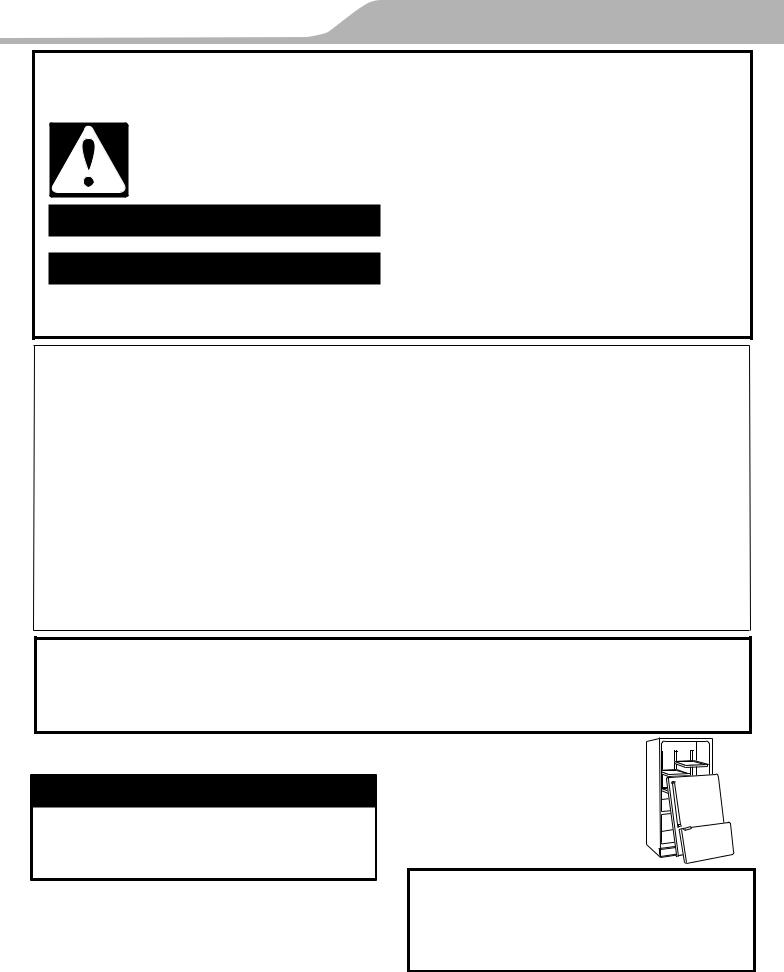
REFRIGERATOR SAFETY
Your safety and the safety of others are very important.
many important safety messages in this manual and on your appliance. Always read and obey all safety
safety alert symbol.
alerts you to potential hazards that can kill or hurt you and others.
messages will follow the safety alert symbol and either the word “DANGER” or “WARNING.”
mean:
 DANGER
DANGER  WARNING
WARNING
You can be killed or seriously injured if you don't immediately follow instructions.
You can be killed or seriously injured if you don't follow instructions.
All safety messages will tell you what the potential hazard is, tell you how to reduce the chance of injury, and tell you what can happen if the instructions are not followed.
IMPORTANT SAFETY INSTRUCTIONS
WARNING: To reduce the risk of fire, electric shock, or injury when using your refrigerator, follow these basic precautions:
■Plug into a grounded 3 prong outlet.
■Do not remove ground prong.
■Do not use an adapter.
■Do not use an extension cord.
■Disconnect power before servicing.
■Replace all parts and panels before operating.
■Remove doors from your old refrigerator.
■Connect to a potable water supply only.
■Use nonflammable cleaner.
■Keep flammable materials and vapors, such as gasoline, away from refrigerator.
■Use two or more people to move and install refrigerator.
■Disconnect power before installing ice maker (on ice maker kit ready models only).
■Use a sturdy glass when dispensing ice (on some models).
■Do not hit the refrigerator glass doors (on some models).
■This appliance is not intended for use by persons (including children) with reduced physical, sensory or mental capabilities, or lack of experience and knowledge, unless they have been given supervision or instruction concerning use of the appliance by a person responsible for their safety.
■Children should be supervised to ensure that they do not play with the appliance.
SAVE THESE INSTRUCTIONS
State of California Proposition 65 Warnings:
WARNING: This product contains one or more chemicals known to the State of California to cause cancer.
WARNING: This product contains one or more chemicals known to the State of California to cause birth defects or other reproductive harm.
Proper Disposal of Your Old Refrigerator
 WARNING
WARNING
Suffocation Hazard Remove doors from your old refrigerator.
Failure to do so can result in death or brain damage.
IMPORTANT: Child entrapment and suffocation are not problems of the past. Junked or abandoned refrigerators are still dangerous—even if they will sit for “just a few days.” If you are getting rid of your old refrigerator, please follow these instructions to help prevent accidents.
Before You Throw Away Your Old Refrigerator or Freezer:
■■ Take off the doors.
■■ Leave the shelves in place so that children may not easily climb inside.
Important information to know about disposal of refrigerants:
Dispose of refrigerator in accordance with Federal and Local regulations. Refrigerants must be evacuated by a licensed, EPA certified refrigerant technician in accordance with established procedures.
3

PARTS AND FEATURES
A B C
I
D
H
 E
E
F
G
J
A.Ice maker
B.Air filter
C.Water filter
D.Door bins
E.Crispers
F.Pantry drawer
G.Freezer drawer
H.LED ramp-on lighting
I.In-Door-Ice® ice dispensing system
J.Pull Out Tray
What’s New Behind the Doors?
Your KitchenAid® French Door Refrigerator comes equipped with various innovative storage and energy efficient features.
Energy and Normal Operating Sounds |
Water Filter |
|
Your new French Door Bottom Mount refrigerator has been |
NSF® Certified filter reduces chlorine taste and odor, particulates |
|
designed to optimize energy efficiency, and better regulate |
(class I), lead, and mercury. Replacing the water filter every 6 |
|
temperatures to match cooling demand. You may notice that it |
months ensures clean, filtered drinking water. |
|
operates differently than your previously owned refrigerator. It is |
Air Filter |
|
normal for the high-efficiency compressor to run for extended |
||
An air filter is 15 times more powerful than baking soda at |
||
periods of time at varying speeds in order to consume only the |
||
energy necessary for optimum efficiency. In addition, during |
reducing common food odors inside the refrigerator. |
|
various stages of the cooling cycle, you may hear normal |
Produce Preserver (on some models) |
|
operating sounds that are unfamiliar to you. |
Ethylene is a natural gas produced by fruits and vegetables to |
|
More Storage Space |
||
promote ripening. The Produce Preserver absorbs ethylene, to |
||
The French Door Bottom Mount has the most fresh food storage |
||
delay the over-ripening of fresh produce. As a result, certain |
||
space available, including a full-width, temperature controlled, |
produce items will stay fresh longer. |
|
pantry drawer perfect for storing veggie trays or party platters. |
Water Dispenser with Measured Fill |
|
In-Door-Ice® Ice Dispensing System |
||
The measured fill feature allows you to dispense the desired |
||
The ice storage bin located in the door provides an entire extra |
||
amount of filtered water. |
||
shelf of storage space and the storage bin is removable for easy |
||
LED Lighting |
||
access to filtered ice. |
||
Dual Evaporator (on some models) |
The LED lights do not ever need to be replaced. |
|
The refrigerator compartment and freezer compartment have |
Shelves with under-shelf lighting (on some models) |
|
separate evaporators to provide fresh food and frozen food with |
||
By moving LED lighting to a new spot under the shelves, this |
||
separate climates. The refrigerator stays cool and humid for the |
||
leading-edge technology elevates the look and feel of your |
||
optimum storage of fresh foods while the freezer stays cold and |
||
refrigerator. |
||
dry. Humidity from the refrigerator does not mix with dry freezer |
||
Door Alarm |
||
air, so frost is controlled, which reduces freezer burn. Since no air |
||
is shared between the refrigerator and freezer, the transfer of food |
A helpful alarm sounds when the refrigerator door or freezer |
|
odors and tastes from the refrigerator to the freezer is eliminated. |
drawer is left ajar. |
|
Pull Out Tray |
Power Outage Indicator |
|
This full-width slide-out shelf tucked between the crispers and the |
If the power should go out while you are away from home, this |
|
lowest shelf is perfect for leftover family-sized casserole dishes, |
indicator will let you know that the refrigerator has been without |
|
pizza boxes, and large party platters. |
power. |
4
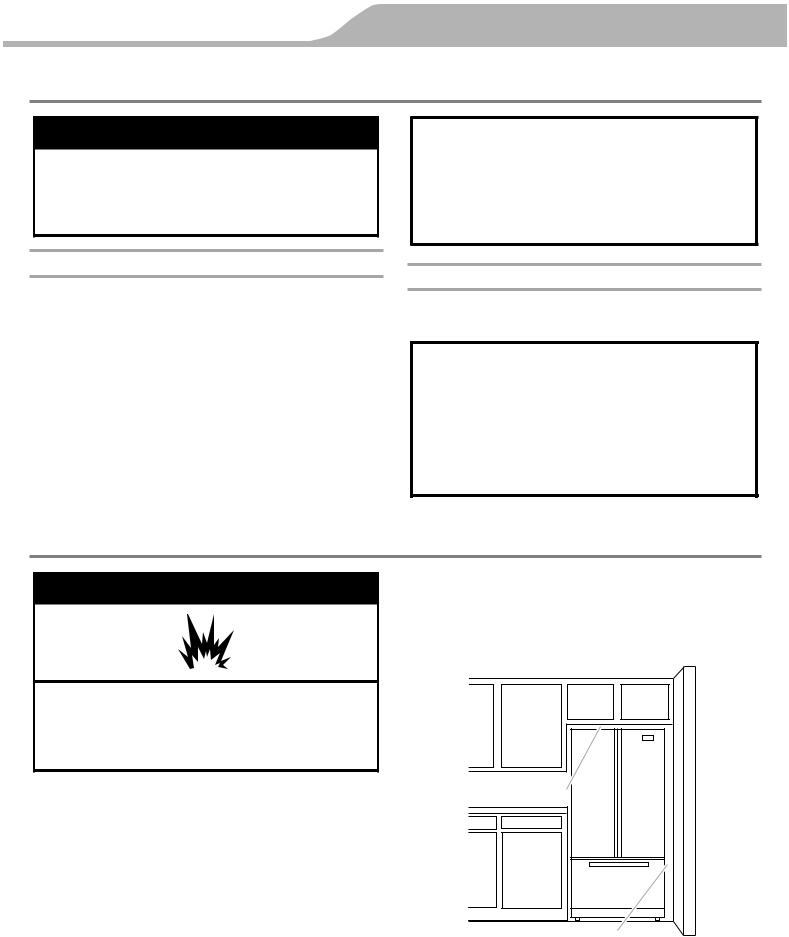
INSTALLATION INSTRUCTIONS
Unpack the Refrigerator
 WARNING
WARNING
Excessive Weight Hazard
Use two or more people to move and install refrigerator.
Failure to do so can result in back or other injury.
Remove the Packaging
■■ Remove tape and glue residue from surfaces before turning on the refrigerator. Rub a small amount of liquid dish soap over the adhesive with your fingers. Wipe with warm water and dry.
■■ Do not use sharp instruments, rubbing alcohol, flammable fluids, or abrasive cleaners to remove tape or glue. These products can damage the surface of your refrigerator.
■■ Dispose of/recycle all packaging materials.
When Moving Your Refrigerator:
Your refrigerator is heavy. When moving the refrigerator for cleaning or service, be sure to cover the oor with cardboard or hardboard to avoid oor damage. Always pull the refrigerator straight out when moving it. Do not wiggle or “walk” the refrigerator when trying to move it, as oor damage could occur.
Clean Before Using
After you remove all of the packaging materials, clean the inside of your refrigerator before using it. See the cleaning instructions in “Refrigerator Care.”
Important information to know about glass shelves and covers:
Do not clean glass shelves or covers with warm water when they are cold. Shelves and covers may break if exposed to sudden temperature changes or impact, such as bumping. Tempered glass is designed to shatter into many small, pebble-size pieces. This is normal. Glass shelves and covers are heavy. Use both hands when removing them to avoid dropping.
Location Requirements
 WARNING
WARNING
Explosion Hazard
Keep ammable materials and vapors, such as gasoline, away from refrigerator.
Failure to do so can result in death, explosion, or re.
IMPORTANT: This refrigerator is designed for indoor, household use only.
To ensure proper ventilation for your refrigerator, allow for a 1/2" (1.25 cm) of space on each side and at the top. Allow for a 1" (2.54 cm) space behind the refrigerator. If your refrigerator has an ice maker, allow extra space at the back for the water line connections. When installing your refrigerator next to a fixed wall, leave a 33/4" (9.5 cm) minimum space between the refrigerator and wall to allow the door to swing open.
NOTE: This refrigerator is intended for use in a location where the temperature ranges from a minimum of 55°F (13°C) to a maximum of 110°F (43°C). The preferred room temperature range for optimum performance, which reduces electricity usage and provides superior cooling, is between 60°F (15°C) and 90°F (32°C). It is recommended that you do not install the refrigerator near a heat source, such as an oven or radiator.
¹⁄ " (1.25 cm)
3³⁄ " (9.5 cm)
5
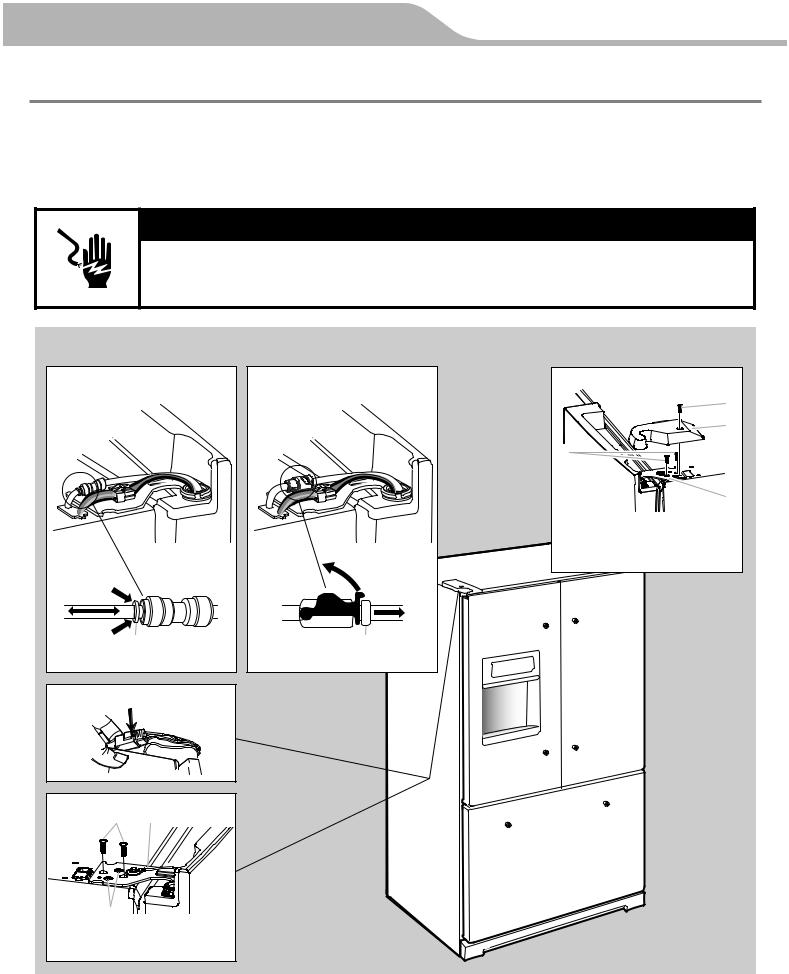
INSTALLATION INSTRUCTIONS
Remove and Replace Refrigerator Doors
NOTE: Measure the width of your door opening, to see whether or not you need to remove the refrigerator doors to move the refrigerator into your home. If door removal is necessary, see the following instructions.
IMPORTANT: If the refrigerator was previously installed and you are moving it out of the home, before you begin, turn the refrigerator control OFF. Unplug the refrigerator or disconnect power. Remove food and adjustable door or utility bins from doors.
Gather the required tools and read all instructions before removing doors. TOOLS NEEDED: 3/16" hexkey wrench and a #2 Phillips screwdriver
 WARNING
WARNING
Electrical Shock Hazard
Disconnect power before removing doors.
Failure to do so can result in death or electrical shock.
|
Door Removal and Replacement |
|
Style 1 – Water Dispenser |
Style 1 – Water Dispenser |
Top Right Hinge |
Tubing Connection |
Tubing Connection |
|
|
|
B |
|
|
C |
|
|
A |
|
|
D |
|
|
A. 3/16" Internal hex-head Screws |
|
|
B. Hinge Cover Screw |
|
|
C. Top Hinge Cover |
|
|
D. Top Hinge |
A |
A |
|
A. Outer Ring |
A. Outer Ring |
|
Wiring Plug
Top Left Hinge
A B
C
A. 3/16" Internal hex-head Screws
B. Ground Wire (Do Not Remove)
C. Screws (Do Not Remove)
6

INSTALLATION INSTRUCTIONS
Remove Right-Hand Refrigerator Door
 WARNING
WARNING
Electrical Shock Hazard Disconnect power before removing doors.
Failure to do so can result in death or electrical shock.
1.Unplug refrigerator or disconnect power.
2.Keep the refrigerator doors closed until you are ready to lift them free from the cabinet.
NOTE: Provide additional support for the refrigerator door while the hinges are being removed. Do not depend on the door gasket magnets to hold the door in place while you are working.
3.Using a Phillips screwdriver, remove the cover from the Top Hinge.
4.Using the 3/16" hex-key wrench, remove the two internal hexhead screws from the top hinge, and set aside.
NOTE: Do not remove the two locator screws. These screws will help you align the hinge when you replace the door.
 A
A
 B
B
C 

 E
E
D
Remove Left-Hand Refrigerator Door
IMPORTANT: The tubing and wiring for the water dispenser run through the left-hand door hinge, so they must be disconnected before removing the door.
1.Using a Phillips screwdriver, remove the cover from the top hinge.
A 

B 
A. Top hinge cover screw |
B. Top hinge cover |
2.Disconnect the water dispenser tubing located on top of the door hinge.
Style 1 - Press the outer ring against the face of the fitting and gently pull the dispenser tubing free.
NOTE: The water dispenser tubing remains attached to the left-hand refrigerator door.
A B
A. Top hinge cover screw |
D. Top Hinge |
B. Top hinge cover |
E. Locator Screws |
C. 3/16" Internal hex-head screws |
|
 WARNING
WARNING
Excessive Weight Hazard
Use two or more people to lift the refrigerator door. Failure to do so can result in back or other injury.
5.Lift the refrigerator door from the bottom hinge pin. The top hinge will come away with the door.
A.Outer ring
B.Face of fitting
7
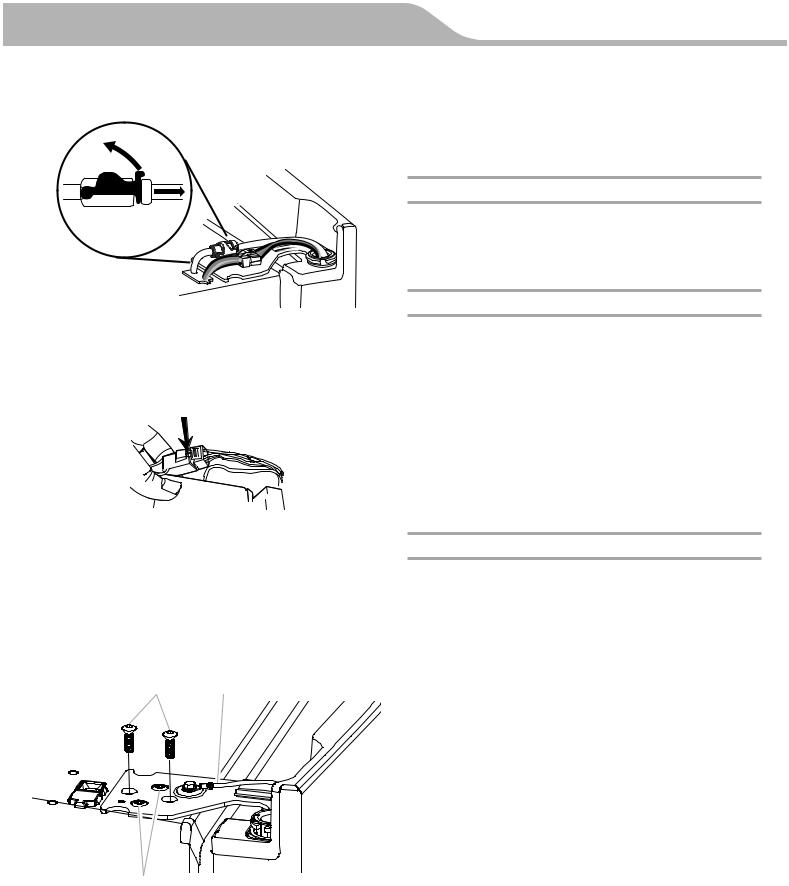
INSTALLATION INSTRUCTIONS
Style 2 - Firmly pull up on the clasp. Then, pull the tubing out of the fitting.
NOTE: The water dispenser tubing remains attached to the left-hand refrigerator door.
3.Disconnect the wiring plug located on top of the door hinge.
■■ Grasp each side of the wiring plug. With your left thumb, press down to release the catch and pull the sections of the plug apart.
NOTE: Do not remove the green, ground wire. It should remain attached to the door hinge.
4.Using the 3/16" hex-key wrench, remove the two internal hexhead screws from the top hinge, and set aside.
NOTES:
■■ Provide additional support for the refrigerator door while the hinges are being removed. Do not depend on the door gasket magnets to hold the door in place while you are working.
■■ Do not remove the two locator screws. These screws will help you align the hinge when you replace the door.
A B
C
A. 3/16" Internal hex-head screws |
C. Locator screws (do not remove) |
B. Ground wire (do not remove) |
|
5.Lift the refrigerator door from the bottom hinge pin. The top hinge will come away with the door.
NOTE: It may not be necessary to remove the bottom hinges and brake feet assemblies to move the refrigerator through a doorway.
■■ Only if necessary, use a driver with a #2 square bit tip to remove the bottom hinges and a 3/8" nut driver to remove the brake feet screws.
Replace Right-Hand Refrigerator Door
1.Set the right-hand door onto the bottom hinge pin.
2.Insert the top hinge pin into the open hole in the top of the refrigerator door.
3.Using the two 3/16" internal hex-head screws, fasten the hinge to the cabinet. Do not tighten the screws completely.
Replace Left-Hand Refrigerator Door
IMPORTANT: Do not intertwine the water tubing and wiring bundles when reconnecting them.
1.Set the left-hand door onto the bottom hinge pin.
2.Using the two 3/16" internal hex-head screws, fasten the hinge to the cabinet. Do not tighten the screws completely.
3.Reconnect the water dispenser tubing.
Style 1 - Insert the tubing into the fitting until it stops and the outer ring is touching the face of fitting.
Style 2 - Insert the tubing firmly into the fitting until it stops. Close the clasp around the tubing. The clasp snaps into place between the fitting and the collar.
4.Reconnect the electrical wiring.
■■ Push together the two sections of the wiring plug.
Final Steps
1.Completely tighten the four internal hex-head screws (two on the right-hand door hinge and two on the left-hand door hinge).
2.Replace both top hinge covers.
8
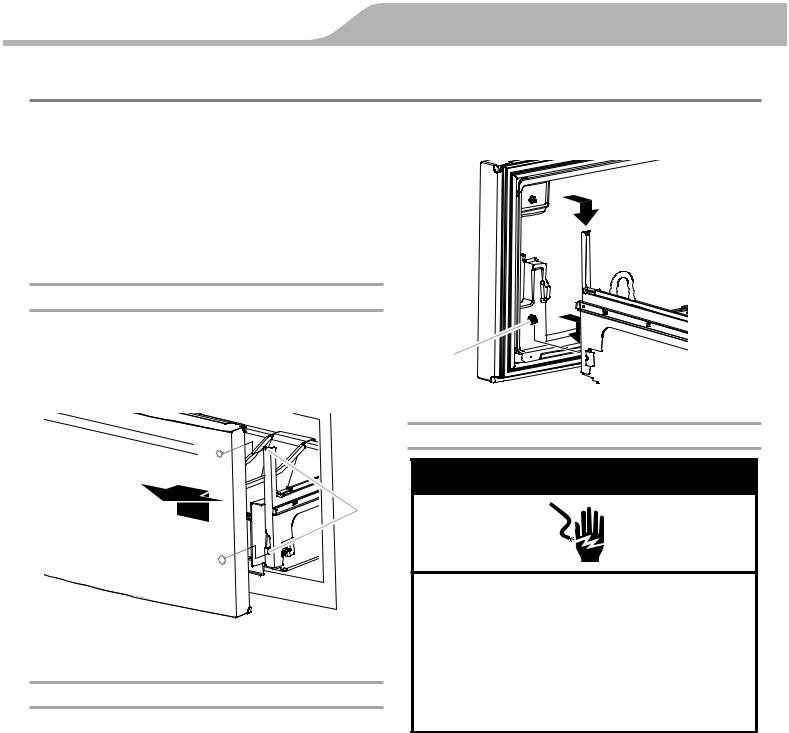
INSTALLATION INSTRUCTIONS
Remove and Replace Freezer Drawer Front
Depending on the width of your door opening, it may be necessary to remove the freezer drawer front to move the refrigerator into your home.
IMPORTANT:
■■ If the refrigerator was previously installed and you are moving it out of the home, before you begin, turn the refrigerator control OFF, and unplug the refrigerator or disconnect power. Remove food from the freezer drawer.
■■ Two people may be required to remove and replace the freezer drawer front.
Tool Needed: 1/4" hex driver
Remove Drawer Front
1.Open the freezer drawer to its full extension.
2.Remove the two screws at the top, inside the drawer front (one on the left-hand side and one on the right-hand side) that fasten the drawer front to the drawer glides.
3.Lift up on the drawer front to release the plastic studs from the drawer glide bracket slots.
A
A.Drawer glide bracket slots
4.Slide the drawer glides back into the freezer.
Replace Drawer Front
1.Pull out the freezer drawer glides to their full extension.
2.Holding the drawer front by its sides, align the two plastic studs, located at the bottom, inside the drawer front, with the drawer glide bracket slots.
NOTE: It helps if one person holds the drawer glides steady while another person aligns the drawer front and inserts the studs into the slots.
3.Replace and tighten the two screws at the top of the drawer front (one on the left-hand side and one on the right-hand side).
A 
B
A.Drawer front screw
B.Drawer front plastic stud
Final Steps
 WARNING
WARNING
Electrical Shock Hazard Plug into a grounded 3 prong outlet. Do not remove ground prong.
Do not use an adapter.
Do not use an extension cord.
Failure to follow these instructions can result in death, fire, or electrical shock.
1.Plug into a grounded 3 prong outlet.
2.Reset the controls. See “Using the Controls.”
3.Return all removable door parts to doors and the food to refrigerator.
9
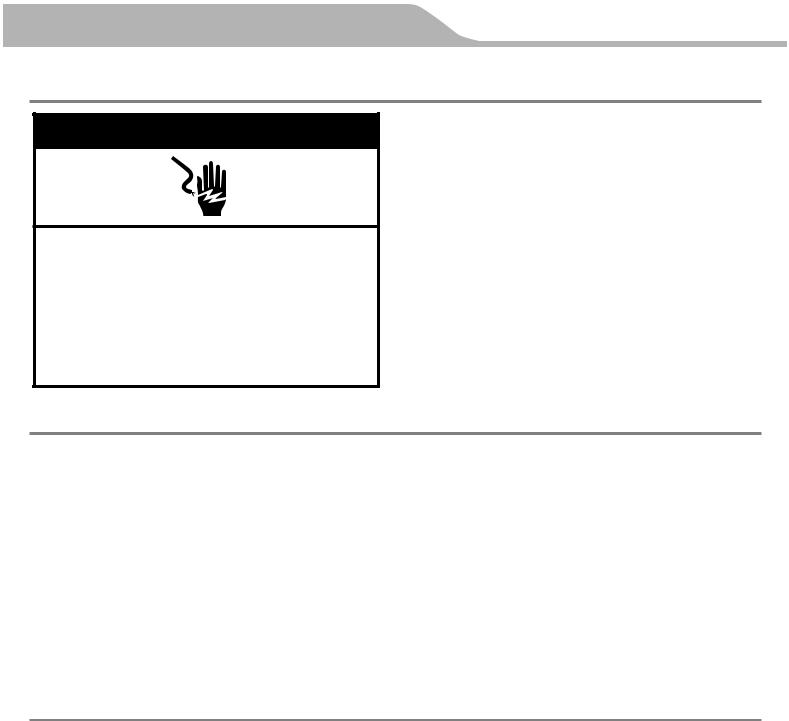
INSTALLATION INSTRUCTIONS
Electrical Requirements
 WARNING
WARNING
Electrical Shock Hazard Plug into a grounded 3 prong outlet. Do not remove ground prong.
Do not use an adapter.
Do not use an extension cord.
Failure to follow these instructions can result in death, fire, or electrical shock.
Before you move your refrigerator into its final location, it is important to make sure you have the proper electrical connection.
Recommended Grounding Method
A 115 volt, 60 Hz, AC only 15 or 20 A fused, grounded electrical supply is required. It is recommended that a separate circuit serving only your refrigerator be provided. Use an outlet that cannot be turned off by a switch. Do not use an extension cord.
NOTE: Before performing any type of installation, cleaning, or removing a light bulb, turn Cooling OFF, and then disconnect the refrigerator from the electrical source. When you have finished, reconnect the refrigerator to the electrical source and turn Cooling ON. See “Using the Controls.”
Water Supply Requirements
A cold water supply with water pressure between 35 and 120 psi (241 and 827 kPa) is required to operate the water dispenser and ice maker. If you have questions about your water pressure, call a licensed, qualified plumber.
NOTE: If the water pressure is less than what is required, the flow of water from the water dispenser could decrease or ice cubes could be hollow or irregular shaped.
Reverse Osmosis Water Supply
IMPORTANT: The pressure of the water supply coming out of a reverse osmosis system going to the water inlet valve of the refrigerator needs to be between 35 and 120 psi (241 and 827 kPa).
If a reverse osmosis water filtration system is connected to your cold water supply, the water pressure to the reverse osmosis system needs to be a minimum of 40 to 60 psi (276 to 414 kPa).
■■ Check to see whether the sediment filter in the reverse osmosis system is blocked. Replace the filter if necessary.
■■ Allow the storage tank on the reverse osmosis system to refill after heavy use. The tank capacity could be too small to keep up with the requirements of the refrigerator.
NOTE: Faucet mounted reverse osmosis systems are not recommended.
■■ If your refrigerator has a water filter, it may further reduce the water pressure when used in conjunction with a reverse
osmosis system. Remove the water filter. See “Water Filtration System.”
If you have questions about your water pressure, call a licensed, qualified plumber.
Connect the Water Supply
Read all directions before you begin.
IMPORTANT:
■■ Plumbing shall be installed in accordance with the International Plumbing Code and any local codes and ordinances.
■■ The gray water tubing on the back of the refrigerator (which is used to connect to the household water line) is a PEX (cross-linked polyethylene) tube. Copper and PEX tubing connections from the household water line to the refrigerator are acceptable, and will help avoid off-taste or odor in your ice or water. Check for leaks.
If PEX tubing is used instead of copper, we recommend the following Whirlpool Part Numbers:
W10505928RP (7 ft [2.14 m] jacketed PEX), 8212547RP (5 ft [1.52 m] PEX), or W10267701RP (25 ft [7.62 m] PEX).
■■ Install tubing only in areas where temperatures will remain above freezing.
TOOLS NEEDED:
Gather the required tools and parts before starting installation. ■■ Flat-blade screwdriver
■■ 7⁄16" and 1/2" open-end wrenches or two adjustable wrenches
■■ 1/4" nut driver
NOTE: Do not use a piercing-type or 3/16" (4.76 mm) saddle valve which reduces water flow and clogs easier.
10

INSTALLATION INSTRUCTIONS
Connect to Water Line
IMPORTANT: If you turn the refrigerator on before the water is connected, turn the ice maker OFF.
1.Unplug refrigerator or disconnect power.
2.Turn OFF main water supply. Turn ON nearest faucet long enough to clear line of water.
3.Use a quarter-turn shutoff valve or the equivalent, served by a 1/2" household supply line.
NOTE: To allow sufficient water flow to the refrigerator, a minimum 1/2" size household supply line is recommended.
Connect to Refrigerator
Follow the connection instructions specific to your model.
Style 1
1.Remove plastic cap from water valve inlet port. Attach the copper tube to the valve inlet using a compression nut and sleeve as shown. Tighten the compression nut. Do not overtighten. Confirm copper tubing is secure by pulling on copper tubing.
2.Create a service loop with the copper tubing. Avoid kinks when coiling the copper tubing. Secure copper tubing to refrigerator cabinet with a “P” clamp.
A |
B |
C
D
A. Sleeve |
C. Copper tubing (to refrigerator) |
B. Nut |
D. Household supply line (1/2" minimum) |
4.Now you are ready to connect the copper tubing to the shutoff valve. Use 1/4" (6.35 mm) OD soft copper tubing to connect the shutoff valve and the refrigerator.
■■ Ensure that you have the proper length needed for the job. Be sure both ends of the copper tubing are cut square.
■■ Slip compression sleeve and compression nut onto copper tubing as shown. Insert end of tubing into outlet end squarely as far as it will go. Screw compression nut onto outlet end with adjustable wrench. Do not overtighten.
A B |
C |
A. Compression sleeve |
C. Copper tubing |
B.Compression nut
5.Place the free end of the tubing into a container or sink, and turn on main water supply to flush out tubing until water is clear. Turn OFF shutoff valve on the water pipe.
NOTE: Always drain the water line before making the final connection to the inlet of the water valve to avoid possible water valve malfunction.
6.Bend the copper tubing to meet the water line inlet, which is located on the back of the refrigerator cabinet as shown. Leave a coil of copper tubing to allow the refrigerator to be pulled out of the cabinet or away from the wall for service.
A
B
C
D
A. Copper tubing |
C. Compression nut |
B. “P” clamp |
D. Compression sleeve |
3.Turn on water supply to refrigerator and check for leaks. Correct any leaks.
Style 2
1.Unplug refrigerator or disconnect power.
2.Remove and discard the short, black plastic part from the end of the water line inlet.
3.Thread the nut onto the end of the tubing. Tighten the nut by hand. Then tighten it with a wrench two more turns. Do not overtighten.
NOTE: To avoid rattling, be sure the copper tubing does not touch the cabinet’s side wall or other parts inside the cabinet.
A |
B |
C |
D |
A. Household water line |
C. Ferrule (purchased) |
||
B. Nut (purchased) |
|
D. Refrigerator water tubing |
|
11

INSTALLATION INSTRUCTIONS
4.Install the water supply tube clamp around the water supply line to reduce strain on the coupling.
5.Turn shutoff valve ON.
6.Check for leaks. Tighten any connections (including connections at the valve) or nuts that leak.
7.On some models, the ice maker is equipped with a built-in water strainer. If your water conditions require a second water strainer, install it in the 1/4" (6.35 mm) water line at either tube connection. Obtain a water strainer from your appliance dealer.
Complete the Installation
 WARNING
WARNING
Electrical Shock Hazard Plug into a grounded 3 prong outlet. Do not remove ground prong.
Do not use an adapter.
Do not use an extension cord.
Failure to follow these instructions can result in death, fire, or electrical shock.
1.Plug into a grounded 3 prong outlet.
2.Flush the water system. See “Water and Ice Dispensers.”
NOTE: Allow 24 hours to produce the first batch of ice. Discard the first three batches of ice produced. Allow 3 days to completely fill the ice storage bin.
Handle Installation and Removal
Parts Included: Door handles (2), Drawer handle(s) (1 or 2 depending on model), 1/8" hex key, spare setscrew(s)
NOTE: With the handles laying on a flat surface, the handles intended for the drawers are more curved. They will not mount flush against the doors.
Install Handles
NOTE: Handle mounting setscrews are preinstalled inside the handle.
1.Remove the handles from the packaging inside the refrigerator, and place them on a soft surface.
2.Open a refrigerator compartment door. On the closed door, place a handle onto the shoulder screws so that the setscrews are facing the adjacent door.
A
B
3.Firmly push the handle toward the door until the handle base is flush against the door.
4.While holding the handle, insert the short end of the hex key into the upper hole and slightly rotate the hex key until it is engaged in the setscrew.
5.Using a clockwise motion tighten the setscrew just until it begins to contact the shoulder screw. Do not fully tighten.
6.Repeat steps 4 and 5 to fasten the lower setscrew.
7.Once both setscrews have been partially tightened as instructed in the previous steps, fully tighten both setscrews.
IMPORTANT: When the screws feel tight, tighten them an additional quarter-turn. The handle is not properly installed without this extra tightening.
A.Shoulder screws
B.Setscrews inside the handle
12
